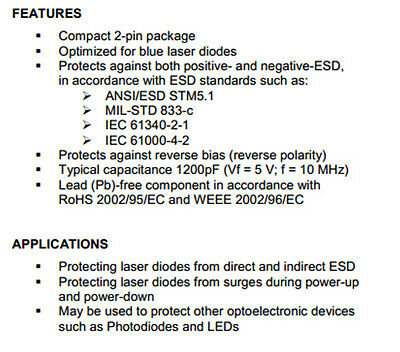-40%
LASORB ESD absorber for laser diodes - Blue frequencies (Pangolin)
$ 5.8
- Description
- Size Guide
Description
AixiZ is a licensed laser manufacturing and service company, Texas license # Z02107. Federal supplier cage code 4MF77.You are purchasing one LASORB EDS protection system for laser diodes for blue (405/445/455) frequencies.
AixiZ is an authorized distributor of Pangolin products.
GENERAL APPLICATION INFORMATION
LASORB is a device that is specifically designed and tested to protect laser diodes from ESD and power
surges. LASORB overcomes the problems of previously-known ESD protection schemes by preventing
reverse-bias of the laser diode under all conditions, and also by preventing ESD or other power-related
faults from exceeding the maximum forward-bias voltage of the laser diode. LASORB is able to do this
while not adding significant resistance or capacitance to the laser system.
CONNECTING LASORB TO THE LASER DIODE
LASORB is connected directly to the terminals of a laser diode. The LDA terminal is connected to the
Laser Diode Anode, and the LDK terminal is connected directly to the Laser Diode Cathode. LASORB
should be connected as closely as possible to the laser diode – certainly no greater than one centimeter
away, thus preventing stray inductance in between the laser diode and the ESD protection means.
NEGATIVE-ESD AND REVERSE-BIAS PROTECTION
LASORB includes a fast-acting diode – the cathode of which is connected to the LDA terminal. The fastacting diode within LASORB has been proven to be generally more robust than a Schottky diode, which is
typically used in an attempt to protect a laser diode. The fast-acting diode within LASORB is able to
protect a laser diode against ESD whose polarity would tend to reverse bias the laser diode, and also
protect the laser diode against pulsed or continuous reverse bias (also known as reverse polarity)
conditions. Normally reverse bias only occurs during an ESD event, or when the power supply is turned
off. As long as the reverse bias condition does not exceed 2.9 amps RMS or 50 amps peak, no additional
reverse bias protection will be needed.
POSITIVE-ESD AND POWER SURGE PROTECTION
LASORB also includes a slew-rate detector, which monitors the voltage between the LDA and LDK
terminals. If the slew-rate is faster than a limit that is predetermined for each specific LASORB part
number, LASORB will conduct current between the LDA and LDK terminals, thus conducting current
away from the laser diode. Using the slew-rate detector, LASORB is able to discern between normal laser
diode operation, and a power surge or ESD event. LASORB also includes other circuitry to enhance its
ability to discern between normal drive conditions and ESD and, because of this additional circuitry,
LASORB is able to protect the laser diode whether power is applied or not.
LEAKAGE CURRENT WHILE INACTIVE
The LASORB device has several degrees of freedom that Pangolin can optimize for a particular type of
laser diode and application. One of the degrees of freedom is the leakage current apparent when
LASORB is inactive (not responding to an ESD event). Generally speaking, higher levels of leakage
current will allow LASORB to better-protect the laser diode while it is lasing. The leakage current is not
temperature dependent and it appears almost purely resistive. If desired, Pangolin can minimize this
leakage current to levels so low, that it appears like a 5 Gig-ohm resistor (1 nA leakage at 5 volts). In
such cases, the ESD protection offered by LASORB is reduced while the laser is lasing. Nevertheless,
ESD protection is still present and very impressive, even though it is reduced when compared to
LASORB models with higher levels of leakage current.
MODULATION CONDITIONS AND PART NUMBER RECOMMENDATIONS
Within this datasheet, we use to the term “current-modulation” to indicate those drivers that maintain a
continuous voltage bias across the laser diode, and only change this voltage slightly during modulation.
We use the term “voltage-modulation” to indicate those drivers that completely remove and re-apply the
nominal terminal voltage across the laser diode during modulation.
In typical laser diode drivers (ones which use current-modulation), the voltage across the laser diode
terminals typically changes very little even during modulation. However, some laser diode drivers (ones
which use voltage-modulation) effectively remove, and then re-apply the nominal terminal voltage
(typically 2.2 to 5.0 V) across the laser diode over and over again. This 100% voltage-modulation may
fool LASORB into believing that there is a power surge condition, and when this happens, LASORB will
conduct current for a brief time, potentially interfering with modulation. To avoid this, you should choose a
specific LASORB part number that corresponds with the maximum expected voltage-modulation rate.
However, if the laser diode driver does not perform 100% voltage-modulation, then practically any
LASORB part will work, and the modulation rate will be primarily dictated by LASORB device capacitance.
Since the dynamic impedance of a typical low power red laser diode is well under 5 ohms, the maximum
modulation rate is greater than 25 MHz when using current-modulation techniques. For higher power red
laser diodes whose dynamic impedance is less than 1 ohm, modulation rates well beyond 100 MHz are
possible. For best results and part number recommendations, it is recommended that OEMs contact
Pangolin for applications advice and laser diode driver review.
AixiZ Service and International LLC 10503 Sageyork Drive, Houston, Texas 77089 USA














